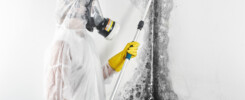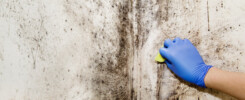Mold is blazing a path across America. There are more than 300,000 types of mold, and most types can grow anywhere in your house and bathroom. Over time, mold can damage your home and cause significant structural problems.
But if you spot mold behind walls, you can take control of the situation. The key is to study the most common signs of a mold problem and figure out the immediate steps to take.
What does mold look and smell like? How can mold affect your paint and wallpaper? How can spores cause allergic reactions, and what can you do about them?
Answer these questions and you can keep your bathroom clean and safe from mold infestations for years to come. Here is your quick guide.
Visible Spores
Mold behind your walls will eventually get out from underneath your walls. You may notice mold growing in the grout between your tiles or along the edge of your tub. If you look inside your walls, you can spot spores anywhere, including on your support beams and drywall.
Spores are very small, so they may be hard to notice. They may be green, black, or brown. You can mistake spores for mildew, wood rot, or another material.
Use a flashlight and a magnifying glass to look for spores. If you are getting close to them, you should put on a mask or respirator so you don’t inhale them.
To test to see if your spots are mold, you should drop a little bleach on them. Bleach will kill mold, but not dirt and other things. If the spots become pale or fall off your walls, you have mold.
Peeling Paint
Mold may become trapped behind your paint. Over time, the spores can push against the paint, causing it to peel or bulge from the wall.
If you notice your paint falling off for no apparent reason, you should inspect the wall for mold. You can use a sanding block or scraper to remove the paint, but don’t scrape your wall or be too aggressive. If you spot spores on the other side of the paint or on your walls, you can order a mold remediation service.
Do not put new paint on your walls until you get your old paint and the spores removed. The new paint will trap the spores and cause a similar problem.
If you have wallpaper in your bathroom, you can look for similar signs. Your wallpaper may start to bulge outward or develop bubbles. If the spores are large enough, they may poke holes through your wallpaper.
Leaking Water
Mold feeds off of water, both in the air and in pools. If you notice damp spots or pools of water in or on your walls, you may have mold growing in them. Even if you don’t have mold currently, you may have mold in the future.
Keep an eye out for leaking pipes. If you notice puddles on the floor or water seeping through your walls, you need to open up your walls and inspect the pipes. Other signs include the sound of water or an unusually high water bill.
Call a plumber who can repair your pipes, then inspect your home for any signs of mold growth. Run a dehumidifier so you remove water from the air and open the windows to promote circulation in your home.
If your house gets flooded, you may develop a mold problem. You can prevent mold after water damage by removing the water immediately, turning on fans, and replacing any damaged materials.
Odors
Mold can create a musty or stale odor. If you smell an odor as you walk into your bathroom, you likely have bathroom mold.
Do not ignore the odor or spray oil to mask the odor. You can open up the windows and doors if you find the odor overpowering, but you then need to call a mold service.
Observe where exactly you notice the smell. It may come from your shower walls, exhaust vent, windows, or another part of your room.
Some types of black mold can create an earthy smell or an odor similar to rotting vegetables. These odors should never be present in a bathroom, so you need to get mold services as soon as possible. You should also read a guide on removing black mold so you know how to contain the situation.
Allergic Reactions
Mold can cause allergic reactions similar to dust and pet hair allergies. You may have a runny nose, watery eyes, or excessive sneezing. If you touch a wall or substance with mold on it, you may have a skin rash.
As time goes on, you may experience a chronic cough, even when you’re not in a room with mold in it. You may develop postnasal drip with phlegm and mucus dripping down the back of your throat.
If you have a pre-existing lung or respiratory condition, exposure to mold can make it worse. In extreme cases, people can have asthma attacks from being in a room with mold.
If you notice you have allergic reactions as you walk into your bathroom, you need to look for mold. Notice if your symptoms go away when you leave your home and get some fresh air.
How to Spot Mold Behind Walls
Mold behind walls will eventually produce a few signs. You may notice mold as it comes out from behind your tiles or panels. If you have paint, the paint may start to fall apart.
Leaking water can provide fuel for mold, especially in your basement. Mold can also create odors and airborne toxins that lead to allergies. As soon as you notice these signs, you should run dehumidifiers and figure out where the mold is.
Then you need to hire a mold restoration company in your area. Big Easy Restoration serves Tampa Bay residents. Contact us today.


